Genre: Puzzle Developer: Digital Developments/DMA Design Publisher: Psygnosis Players: 1 Released: 1994
The original Lemmings was and to this day remains to be one of the most widely ported games of all time. Its premise – save a bunch of oblivious critters from certain doom and guide them safely to the exit – was as simple as it was brilliant and birthed an entire sub-genre of real-time strategic puzzle games. According to Mike Dailly, who designed the original character sprites, the game sold more copies in its first day than your typical Amiga game tended to sell in its entire distribution life cycle. Needless to say, with such a major success under its belt, publisher Psygnosis wanted milk that cash cow as much as possible. First, the original game with its 120 levels was ported to every computer and console known to exist back then, even to some of the most exotic fringe systems (SAM Coupé, anyone?). Next, the most popular home computer versions (PC and Amiga, respectively) were soon followed up with a Data disk – the expansion packs of their time – called Oh No! More Lemmings, which consisted of an additional 100 levels, each tougher than the toughest of the first game (some of which made it into the Mega Drive port). Then came Holiday Lemmings, new Christmas-themed levels released as demos around the end of 1991, 1992 and 1993 respectively and later bundled into two stand-alone sets for home computers. All of these still used the same mechanics and mostly the same assets of the original game. And then, in 1993, there eventually followed a true sequel. While not as widely ported as the first game in the series, it nevertheless saw a decent number of different versions, and in 1994 it also found its way to the Mega Drive.
So, what is Lemmings 2 all about? After a guide safely led them through many hazards into a new land (bet you didn’t know that the first game had a backstory, did you? Well, now it retroactively does), the Lemmings have split into 12 different tribes. Each of them took a piece of their guiding talisman, so that they may prosper and grow. But a prophecy tells of a Great Darkness that will soon sweep upon the land. So the tribes have to get together, rejoin the guiding talisman and set out for a new home once more. But in order to safely evacuate all the 12 tribes, a guiding force is needed. The same guide who saved the Lemmings once before – you, the player!
Once again, the aim of the game is the same: a bunch of critters gets dropped into a level and immediately start running from left to right, oblivious to any hazard that there might be. Water, acid, pitfalls, even animals or strange contraptions – like a vacuum that sucks the Lemmings into the air and then grinds them up like a mixer – immediately kill the poor creatures. Should they run into a wall or a similar obstacle, they turn around and walk in the other direction. In order to reach the exit, you have to endow individual Lemmings with certain abilities that allows them to clear the dangers and create a safe path to the exit.
As any proper sequel should, Lemmings 2 takes the original mechanics and heavily expands upon them. For example, instead of clearing 30 levels sorted into four different difficulties, you now get 12 different tribes with 10 stages each. These all have a certain theme depending on the tribe chosen. The beach Lemmings, for example, have sun, sand and surf (aka water hazards). Other sets are sports, Egyptian, caveman, outdoor or circus Lemmings. Most tribes have slight optical variations: the highland Lemmings are red-haired instead of having the typical green-hair, blue-clothes style most other tribes have, while beach Lemmings are sporting a tan, and the shadow tribe is clad in ninja garb for example. There’s also a classic tribe, which is pretty much like the one in the original game in abilities and looks. No matter what tribe is at play, in each stage you have limited number of certain abilities at your disposal. Whereas the original occasionally used the same layout of a stage but switched around the abilities and goals needed to successfully clear it, however, all 120 levels are completely different here. This time, there’s also an actual ending sequence to the game, giving players an incentive to try and see the game all the way through this time around.
Speaking of ends and incentives, this is another thing Lemmings 2 switches around: In the original, each level started with a certain amount of Lemmings (reaching from 1 to 99, differing from stage to stage), of which you had to save a certain percentage to successfully pass it. Now, however, each tribe always starts out with 50 Lemmings. That’s something that differentiates this port both from the original home computer version and its SNES counterpart, by the way. PC and Amiga users had to handle 60 Lemmings simultaneously, while on the SNES, you start out with only 40.
In order to successfully clear the level, you only need to save one single critter – in theory. There’s a catch. though. Each Lemming you saved is taken into the next stage; the others are lost forever. So the fewer creatures reach the exit, the harder it gets to clear the following levels. At the end of each level you get graded with bronze, silver and gold medals for your performance. In order to see the ending, you need at least 20 Lemmings left after the tenth stage of each tribe. So, while in the original game and its expansions it absolutely sufficed to barely get past that minimum requirement, this time players actually are encouraged to revisit the stages and try new ways and new strategies that might enable them to save more critters. Most levels can be cleared differently, utilizing different abilities, and it can be a lot of fun figuring out new ways to beat an old stage more efficiently. Most of the time, but not always, the major trick is finding a way to safely corral most of your Lemmings while a small contingent clears the way, and only then releasing the rest.
While the original held only eight different abilities you could choose from, in Lemmings 2 there are now a whopping 50 of them! Thankfully, you never have to choose from the whole skill set in any given level; each stage gives you a certain quantity of no more than eight different abilities, most of them even less, to choose from in order to find a viable solution. However, all these different skills make it hard to discern what just might be the right tool to pick for the task at hand. To offset this, the game allows you to enter training stages where you can pick eight abilities of your own choosing and play around with them a bit, to see how they work. Some of them are variations of a similar method. For example, in the original game, in order to pass pits, you could only build 12 steps leading diagonally upward. Now, there are different skills more or less filling the same gap, just in different ways. There are now different kind of block builders that can build diagonally, horizontally or stack blocks vertically respectively. There are now Lemming who can fill pits with glue, not to be confused with those who can empty buckets of sands to create hills. Obstacles can be destroyed in different manners, the most impressive of which are probably the flamethrower (blowing out huge chunks of destructible walls on a horizontal plane) and the laser cannon (which does a similar thing vertically). There is a music Lemming that causes all the others to dance and remain firmly in place (and, as a nice touch, uses a different instrument for each tribe. The beach Lemming uses a boombox for example, while the medieval Lemming breaks out a lute). Also, there are now different flying abilities, ranging from the classic parasol to hang gliders and even jet packs. And so on and so forth.
Aside from the virtual buttload of new skills, there have been other additions to the gameplay. Most importantly, if Lemmings drop from a certain height, there are stunned for a bit before they move again – only if they fall even further, they splat and die, so drop distance now works a bit differently. Also, not every obstacle in a level is a death trap. For example, in medieval stages there is a catapult that tosses Lemmings around once they enter it. This can be dangerous, but you can also utilize that into your solutions. Things are similar with explosions, which now toss other Lemmings in their blast wildly around. An entirely new icon is the fan. You can use this to blow air, allowing surfer Lemmings to move across water or to influence the flight paths of Lemmings with flying abilities. To do so, you need to quickly select the fan, move the cursor where you want to blow the air, and then rapidly hit the button to spin the blades and create the airflow. Needless to say, this takes a lot of practice in order to get the timing just right and get the hang of it.
As impressive as this may seem, this abundance of game mechanics causes a little problem. The sequel is a lot harder to access than the first game was. There is just so much to take care of and to memorize, so many intricate abilities and obstacles to learn, so many idiosyncrasies to get a feeling for. This might be great news for someone who can clear all stages of the first game blindfolded and is craving for a new challenge, something that is completely different yet the same. For newcomers or gamers who enjoyed the original in short, sporadic bursts, this may be too much to take in at once. The original game had the perfect difficulty curve: The first few levels in “fun” taught you the different abilities pretty much one by one, allowing newcomers to ease into the game without overly tutorializing it. In Lemmings 2, you don’t learn the skills one by one, you have to figure them out right from the moment you hear the iconic “Let’s go!” announcement. All you have to help you along is the practice mode where you can experiment at random, but you won’t find any explanation how a skill works; you have to find out by yourself. That might be okay when you only had eight abilities in total, but it gets pretty tough to keep the differences of 50 skills in mind, especially if there’s only a minor variety between some of them. It would have been easier if certain skill sets were relegated to certain tribes, but that isn’t the case. Instead, they are mixed wildly, which makes it a bit odd if even the beach tribe will use laser cannons and jet packs, which thematically fit better into the space setting.
Also, difficulties aren’t categorized, so if you believed that the twelve tribes are more or less sorted into 12 different skill levels, you’d be mistaken. Sure, some of them are a bit easier to start out with than others. You may have a much harder time saving all Lemmings in the first space stage than in the beach setting, and the first beach stage is a lot tougher than the Egyptian one, respectively. But there is no overarching curve where the difficulty gets progressively harder. If you get stuck with one tribe, you should back out of that theme, try another for a while and get back to the former later on. Which is doubly unfortunate, because instead of saving your current state, the Mega Drive version uses passwords – for each tribe individually! Since these trace how many Lemmings have been saved into each and every one of a tribe’s levels, they turn out to be very long as well. So if you want to continue where you left off and want to see the ending at some point, you will have to enter twelve different passwords – one for each tribe – before you can pass what amounts to the final level in your playthrough. Needless to say, this causes a lot of unnecessary frustration.
There are two more areas where the developers dropped the ball. Firstly, the two-player-mode from the first game is gone – no more direct competition where to game pad jockeys could match their wits against each other. Secondly, when porting the game to the Mega Drive, the developers did not implement mouse support. This is very unfortunate, since timing and pinpoint accuracy are very crucial in this game, something where mouse controls would definitely have been superior than a game pad. The Mega Mouse had already been available for quite a while, and the SNES version did receive mouse support, which makes the omission a bit baffling.
On a more positive note, the audio is pretty good. While Lemmings had some catchy tunes, the Genesis port suffered in the aural department and had relatively tinny and bleepy renditions. For this game though, Matt Furniss was brought in to handle the music for the Mega Drive port, who definitely knew his way around the consoles sound hardware. He even composed a few original tracks that can only be found in this version. Each tribe has its own theme song; the Highland tribe has a tune derived from “Scotland the Brave,” the Beach tribe got some beach rock tunes, the polar theme kinda of resembles “Rudolph, the Red-Nosed Reindeer and so forth. Overall, the soundtrack is pretty good, perhaps even better than the home computer original by Brian Johnston. It fits the mood of the game perfectly and can even be enjoyed on its own from time to time, if you’re into easy listening. Since every level in each tribe uses the same respective song, however, playing with a single theme for an extended period of time might get a bit repetitive audio-wise, but that’s only a minor gripe.
The graphics have also been improved over the first game, though it may not be apparent judging from first impressions: The main screen and intro look grainy, with some jerky animations, an unfortunate side effect from the downgrade in terms of color palette the game had to undergo after being ported from home computers. In-game, however, the graphics are fully serviceable. They are colorful and pretty clear, not as murky as in the first game. The skill bar at the bottom of the screen displaying all the abilities available has been increased in size. which is a bit of a double-edged sword: It makes selecting the right tool at the right moment easier with the game pad, but it also results in the screen getting more cramped, making it harder to keep control of the action. There’s also no map screen any more, so you find yourself pausing the game mid-level every once in a while, parsing the screen in order to judge what to do next. It may come to little surprise that the SNES-port is looking better than the one for the Genesis, since that one has more elaborate background graphics and an overall more detailed look. But on the other hand, the Genesis version has more Lemmings onscreen at the same time and runs a bit smoother, a trade off I am comfortable with.
If you liked the first game and mastered every instance of it, then you will love Lemmings 2. The developers took the essence of what made the first game great and built upon it, adding more abilities, more themes, more incentives to go and revisit old levels, and this time around, even a real ending (well, sort of). For newcomers and casual players, this game is a tougher sell. The learning curve is very steep, there is no proper tutorial to get a hang of all the new mechanics, and without a solid foundation in knowing what to do, the game soon becomes very difficult to handle. It’s almost as if the developers had become too good at their own game and forgot that, maybe, some people still needed to ease into all the new stuff. The Mega Drive version also suffers from lacking both battery saves and mouse support. That isn’t to say that Lemmings 2 is a bad game, far from it. The design is good, the soundtrack by Matt Furniss is great, and the gameplay is as fresh and challenging as ever. But in order to draw the most enjoyment from it, I recommend playing through any incarnation of the first game beforehand. Then, if you’re hooked and craving for more, the sequel will serve perfectly in fulfilling that desire. In that case, feel free to add one point to the score.
SCORE: 7 out of 10

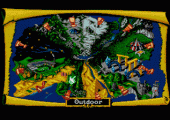
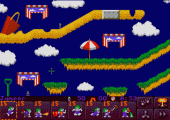
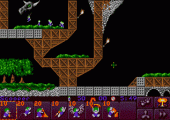

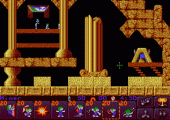
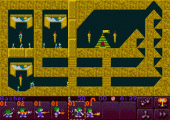
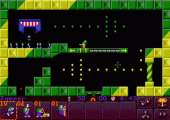


Recent Comments